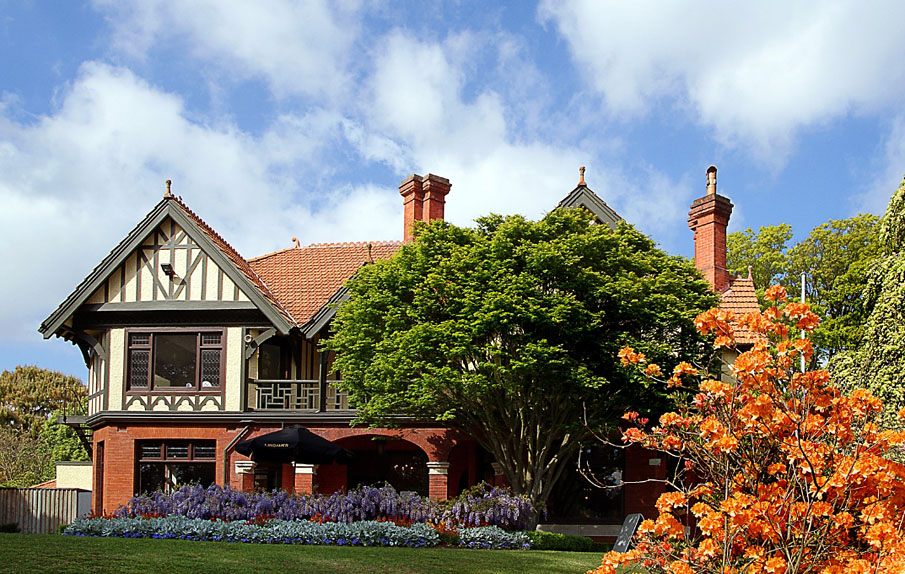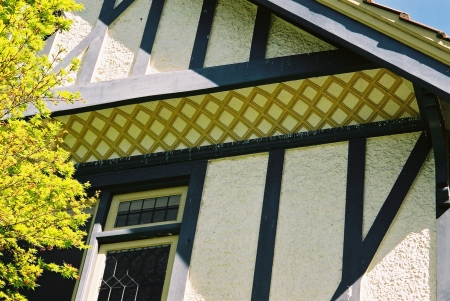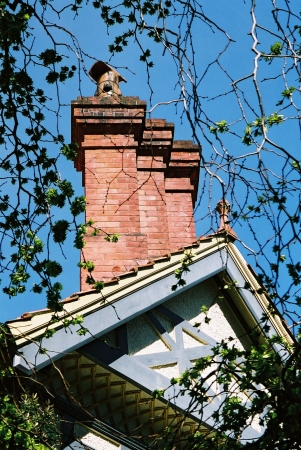The house Maddison designed is two-storeyed and constructed in brick. The upper storey is stuccoed and half timbered on the upper storey, a reference to the houses of Tudor England. With its English vernacular motifs and tiled roof, the building is characteristic of a number of houses in Christchurch designed for well-off professionals and businessmen around the turn of the century. Such houses were influenced by the Arts and Crafts movement in Britain, as experienced in New Zealand. The Arts and Crafts movement in architecture grew out of an interest in traditional construction and the moral worth of honest toil.
In 1905 Waymouth sold his house to Annie Townend (?-1914) and it was she who renamed the place Mona Vale, after her mother's house in Tasmania. Annie Townend was the daughter of one of the wealthiest runholders in Canterbury, George Moore of Glenmark. After her father's death in 1905, Townend continued to run Glenmark. She built the gatehouse at Mona Vale, which is also registered by the New Zealand Historic Places Trust/Pouhere Taonga. Townend also installed a fernery at Mona Vale; she acquired the building and its ferns from the International Exhibition held at Hagley Park in 1906-1907.
The four hectares of gardens around Mona Vale greatly contribute to the charm of the property. The house is orientated to the river and surrounded by lawns and other 'horticultural delights'. In 1939, when Mona Vale was owned by Tracy Gough, Alfred Buxton, the noted Canterbury landscape architect, was employed to lay out the gardens.
In 1962 the property was sold to the Church of the Latter Day Saints, also known as the Mormons. A few years later the Church wished to subdivide the property and demolish the house. The public outcry that this caused led to the purchase of the property by the Christchurch City Council, helped by a local fund-raising campaign. Since then it has primarily been used as a restaurant and function centre.
Mona Vale is significant as an example of Maddison's domestic architecture, and as a representative of the 'Old English' style house, which became a notable part of Christchurch's architectural heritage. It reflects the lifestyle of the wealthier residents of Christchurch at the turn of the century and it has immense public significance as a valued 'oasis in the heart' of Christchurch.
'Over time the property has undergone considerable change through the interests of its owners and the purchase of further land holdings incorporated into the site. It is noted by Louise Beaumont in her 2009 Landscape Conservation Plan, p.3, that it was "firstly designed as the ornamental pleasure grounds associated with a town estate, and then as the extended grounds of a church facility. More recently it has functioned as a passive-recreation, historic and garden/park developed around the extant historic buildings, structures and plant fabric."



Location
List Entry Information
Overview
Detailed List Entry
Status
Listed
List Entry Status
Historic Place Category 1
Access
Able to Visit
List Number
283
Date Entered
7th April 1983
Date of Effect
7th April 1983
City/District Council
Christchurch City
Region
Canterbury Region
Legal description
Lot 9 DP 7787 (RT CB13K/1092), Canterbury Land District.
Location Description
The homestead is set in extensive grounds located between the Wairarapa Stream and South Island Main Trunk railway line, with vehicle access from Fendalton Road and Mona Vale Avenue. The grounds contain a number of ancillary buildings, including two gatehouses, a Bath House, a fernery and a number of bridges. The Homestead has high contextual significance in relation to its immediate setting, as the principal dwelling on the site. It also has a connection with Mona Vale's former stable block, now a dwelling on Matai Street, west of the rail line.
Stay up to date with Heritage this month

